Techno-Economic Feasibility of the Longwall Top Coal Caving Method Based on the FTCD Index: A Parametric Case Study in India
Abstract
:1. Introduction
2. Numerical Modeling for Evaluation of LTCC Parameters
2.1. Model Development
2.2. Parametric Study and Numerical Modeling
3. Results and Analysis of Numerical Modeling
3.1. Summary of the Parameters and Results of the 20 Cases
- The strength of the top coal (UCS) has a direct relation with TFCD with a good correlation (R2 = 0.97), as shown in Figure 7(i). As the strength of coal increases, difficulty in caving increases.
- The CMRI-ISM RMR (a factor considered to represent the effect of discontinuities) is higher for the coal mass with a lower density of discontinuities. The TFCD has shown a direct relationship (R2 = 1.0) with the CMRI-ISM RMR, as shown in Figure 7(ii).
- An increase in depth of working eases the top coal caveability. As the depth increased from 300 m to 600 m, the TFCD reduced from 6 m to 3 m, showing an inverse relationship with a good correlation of R2 = 0.852, as shown in Figure 7(iii).
- The thickness of the top coal has a significant direct relation with the TFCD. As the top coal thickness increased from thickness varies directly (R2 = 0.988) from 2.6 m to 6 m, the TFCD also increased from 3 m to 8 m, as shown in Figure 7(iv). Thus, an increase in top coal thickness results in poorer caveability.
- The effect of the cutting height on TFCD has shown that for an extraction height of 3 m, the TFCD is only 5 m, and when the cutting height is enhanced from 3.5 m, the TFCD increased to 4 m, and there is no improvement in TFCD despite the extraction height increasing from 4 m to 4.5 m, as shown in Figure 7(v). The correlation between the cutting height and TFCD is found to be only 0.6.
3.2. Regression Analysis of Numerical Modeling Results
- FTCD = First Top Coal Caving Distance (m);
- EH = bottom coal extraction height (m);
- TC = top coal thickness (m);
- RMR = RMR of coal (0–100);
- UCS = uniaxial compressive strength of coal (MPa);
- H = depth of the coal seam from surface (m).
3.3. Correlation of Values by Analytical Simulation and Numerical Modeling
3.4. Validation from the ALP Mine
3.5. Geo-Mining Conditions of the Site
4. Economic Evaluation of LTCC—A Case Study
Equipment Selection for LTCC Adoption in the No. 1 Seam of the GVCF
5. Discussion and Conclusions
Author Contributions
Funding
Institutional Review Board Statement
Informed Consent Statement
Data Availability Statement
Acknowledgments
Conflicts of Interest
References
- Balasubramanyam, N.; Budi, G. A Study into the Feasibility of application of Longwall Top Coal Caving (LTCC) method in Indian Geo-Mining Conditions. In Proceedings of the International Conference on Deep Excavation, Energy Resources and Production (DEEP-)16, Kharagpur, India, 24–26 January 2017. [Google Scholar]
- Singh, T.N.; Kushwaha, A.; Singh, R.; Singh, R. Strata behavior during slicing of thick seam at East Katras Colliery. In Proceedings of International Symposium on Thick Seam Mining; Singh, T.N., Dhar, B.B., Eds.; Central Mining Research Station: Dhanbad, India, 1992; pp. 237–250. [Google Scholar]
- Hebblewhite, B.K.; Cai, Y.J. Evaluation of the application of the Longwall Top Coal Caving (LTCC) method in Australia. In Proceedings of the 13th International Conference on Coal Research, Shanghai, China, 26–29 October 2004; China National Coal Association: Beijing, China, 2004; pp. 368–374. [Google Scholar]
- Khanal, M.; Adhikary, D.; Balusu, R. Evaluation of Mine Scale Longwall Top Coal Caving Parameters using Continuum Analysis. Min. Sci. Technol. China 2011, 21, 787–796. [Google Scholar] [CrossRef]
- Le, T.D.; Mitra, R.; Oh, J.; Hebblewhite, B. A review of cavability evaluation in Longwall top coal caving. Int. J. Min. Sci. Technol. 2017, 27, 907–915. [Google Scholar] [CrossRef]
- Yasitli, N.E.; Unver, B. 3D numerical modeling of longwall mining with top-coal caving. Int. J. Rock Mech. Min. Sci. 2005, 42, 219–235. [Google Scholar] [CrossRef]
- Xie, H.; Chen, Z.; Wang, J. Three-dimensional numerical analysis of deformation and failure during top coal caving. Int. J. Rock Mech. Min. Sci. 1999, 36, 651–658. [Google Scholar] [CrossRef]
- Humphries, P.; Poulsen, B.; Ren, T. Longwall Top Coal Caving Application Assessment in Australia; Commonwealth Scientific and Industrial Research Organisation: Brisbane, Australia, 2006. [Google Scholar]
- Yao-She, X.; Yang-Sheng, Z. Technique of top coal caving with vibration. In Proceedings of the 6th International Conference on Mining Science & Technology, Seoul, Korea, 24–26 November 2009; Volume 1, pp. 219–226. [Google Scholar]
- Xu, B. Application of the Longwall Top Coal Caving System in Australian Thick Seam Coal Mines. Ph.D. Thesis, The University of New South Wales, Sydney, Australia, 2004. [Google Scholar]
- Vakili, A. Cavability Assessment in Longwall Top Coal Caving Technology. Ph.D. Thesis, The University of New South Wales, Sydney, Australia, 2009. [Google Scholar]
- Dao, H.Q. The Effect of Seam Dip on the Application of the Longwall Top. Coal Caving Method for Inclined Thick Seams; The University of New South Wales: Sydney, Australia, 2010. [Google Scholar]
- Vakili, A.; Hebblewhite, B.K. A new cavability assessment criterion for Longwall Top Coal Caving. Int. J. Rock Mech. Min. Sci. 2010, 47, 1317–1329. [Google Scholar] [CrossRef]
- Das, S.K. Observations and classification of roof strata behaviour over longwall coal mining panels in India. Int. J. Rock Mech. Min. Sci. 2000, 37, 585–597. [Google Scholar] [CrossRef]
- Venkateswarlu, V.; Ghose, A.K.; Raju, N.M. Rock-mass classification for design of roof supports—a statistical evaluation of parameters. Min. Sci. Technol. 1989, 8, 97–107. [Google Scholar] [CrossRef]
- Kumar, B.M.; Maiti, J.; Mandal, P.K. Numerical Modelling Based study in Bord and Pillar working—A prerequisite for support design in mines. Minetech 2007, 28, 19–28. [Google Scholar]
- Paul, A.; Singh, A.P.; Loui, J.; Singh, A.K.; Khandelwal, M. Validation of RMR-based support design using roof bolts by numerical modeling for underground coal mine of Monnet Ispat, Raigarh, India—a case study. Arab. J. Geosci. 2012, 5, 1435–1448. [Google Scholar] [CrossRef]
- Singh, A.K.; Sinha, S.K.; Paul, A. Variation of RMR for different rock types as immediate roof in Jharia Coalfield of India. Int. J. Softw. Hardw. Res. Eng. 2013, 1, 44–55. [Google Scholar]
- Paul, A.; Murthy, V.M.S.R.; Singh, A.K. Rock Load Estimation in development Galleries and Junctions for Underground Coal Mines: A CMRI-ISM Rock Mass Rating Approach. Hindawi Publ. Corp. J. Min. 2014, 2014, 9. [Google Scholar] [CrossRef] [Green Version]
- Shorey, P.R.; Biswas, A.K.; Choubey, V.D. An empirical failure criterion for rocks and jointed rock masses. Eng. Geol. 1989, 26, 141–159. [Google Scholar] [CrossRef]
- Shi, N.; Huang, Z. Application of Longwall Top Coal Caving in Challenging Geological Conditions. In Proceedings of the World Congress on Mechanical, Chemical, and Material Engineering (MCM 2015), Barcelona, Spain, 20–21 July 2015. [Google Scholar]
- Klishin, V.; Nikitenko, S.; Opruk, G. Longwall top coal caving (LTCC) mining technologies with roof softening by hydraulic fracturing method. IOP Conf. Ser. Mater. Sci. Eng. 2018, 354, 012015. [Google Scholar] [CrossRef]
- Simsir, F.; Özfırat, M.K. Determination of the most effective longwall equipment combination in longwall top coal caving (LTCC) method by simulation modelling. Int. J. Rock Mech. Min. Sci. 2008, 45, 1015–1023. [Google Scholar] [CrossRef]
- Galvin, J.M. Ground Engineering—Principles and Practices for Underground Coal Mining; Springer International Publishing: Cham, Switzerland, 2016. [Google Scholar]
- Khanal, M.; Adhikary, D.; Balusu, R. Prefeasibility Study—Geotechnical Studies for Introducing Longwall Top Coal Caving in Indian Mines. J. Min. Sci. 2014, 50, 719–732. [Google Scholar] [CrossRef]
- Xie, Y.S.; Zhao, Y.S. Numerical simulation of the top coal caving process using the discrete element method. Int. J. Rock Mech. Min. Sci. 2009, 46, 983–991. [Google Scholar] [CrossRef]
- Xie, G.X.; Chang, J.C.; Yang, K. Investigations into stress shell characteristics of surrounding rock in fully mechanized top-coal caving face. Int. J. Rock Mech. Min. Sci. 2009, 46, 172–181. [Google Scholar] [CrossRef]
- Wang, J.; Yang, S.; Li, Y.; Wei, L.; Liu, H. Caving mechanisms of loose top-coal in longwall top-coal caving mining method. Int. J. Rock Mech. Min. Sci. 2014, 71, 160–170. [Google Scholar] [CrossRef]
- Xin, Y.; Gou, P.; Ge, F. Analysis of stability of support and surrounding rock in mining top coal of inclined coal seam. Int. J. Min. Sci. Technol. 2014, 24, 63–68. [Google Scholar] [CrossRef]
- Zhou, Y.; Li, H.; Zhai, X.; Su, C. Simulated materials modeling and analysis of the overburden strata movement in top coal caving mining. In Proceedings of the 20th International Conference on Ground Control in Mining, Morgantown, WV, USA, 7–9 August 2001; pp. 50–58. [Google Scholar]
- Zhang, N.; Liu, C. Arch structure effect of the coal gangue flow of the fully mechanized caving in special thick coal seam and its impact on the loss of top coal. Int. J. Min. Sci. Technol. 2016, 26, 593–599. [Google Scholar] [CrossRef]
- Alehossein, H.; Poulsen, B.A. Stress analysis of longwall top coal caving. Int. J. Rock Mech. Min. Sci. 2010, 47, 30–41. [Google Scholar] [CrossRef]
- Itasca. FLAC Version 4.0 User’s Manual; Itasca Consulting Group, Inc.: Minneapolis, MN, USA, 2000. [Google Scholar]
- Veera Reddy, B.; Madhav, B.; Charan, P.; Benerjee, G. Geotechnical challenges and experiences of working a deep and wide Longwall face: A case study of Adriyala Longwall project, SCCL. In Proceedings of the 36th International Conference on Ground Control in Mining, Morgantown, WV, USA, 24–27 July 2017; pp. 43–51. [Google Scholar]
- Mirakovski, D.; Krstev, B.; Krstev, A.; Petrovski, F. Mine Project Evaluation Techniques. Available online: https://eprints.ugd.edu.mk/3735/ (accessed on 4 February 2013).
- Government of India. Gazette Notification No. 22021/1/2008-CRC-II, Dated 30.12.2011; Ministry of Coal: New Delhi, India. Available online: https://ccai.co.in/circular-policies/ministry-coal/06.pdf (accessed on 25 September 2021).
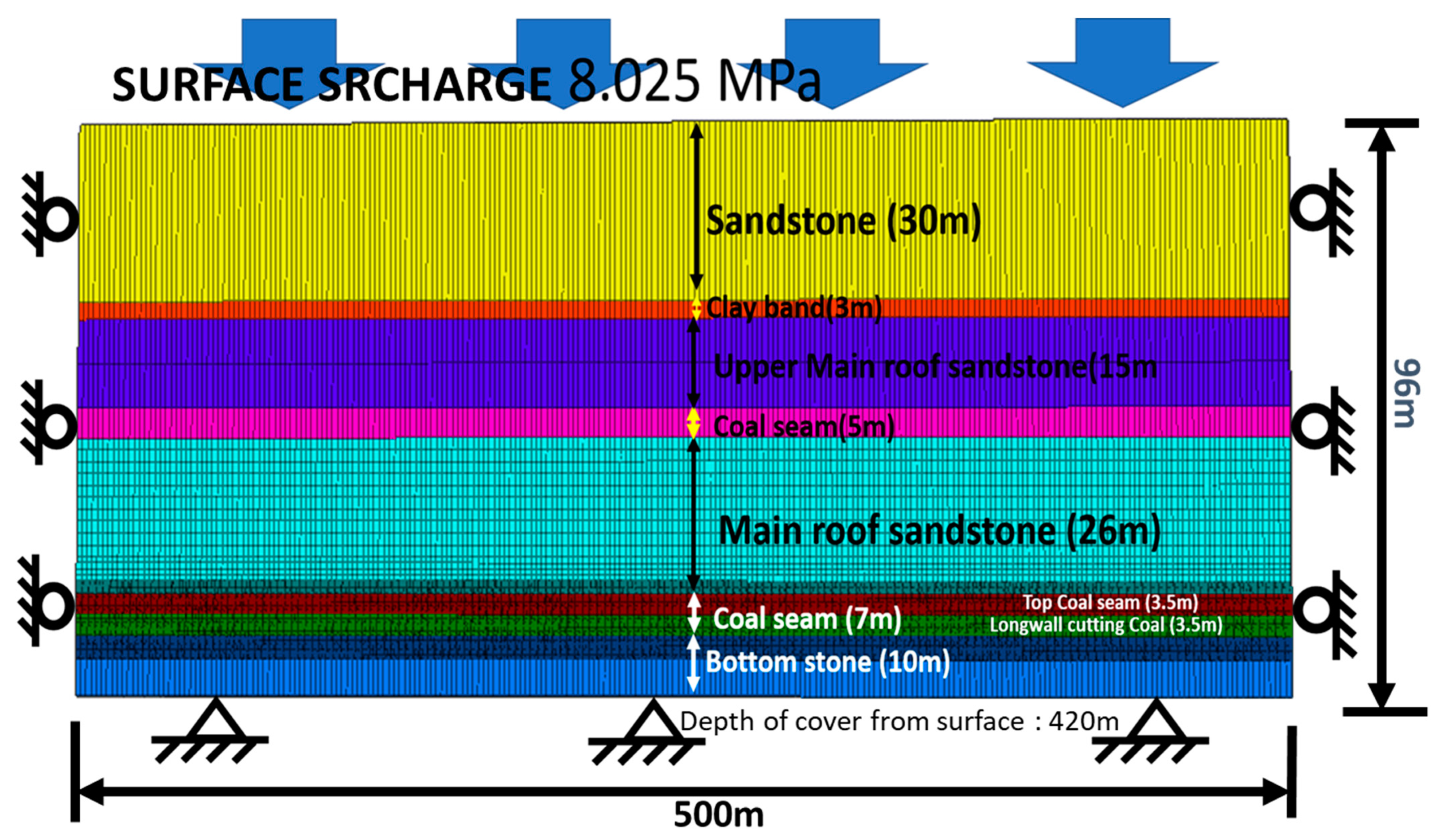
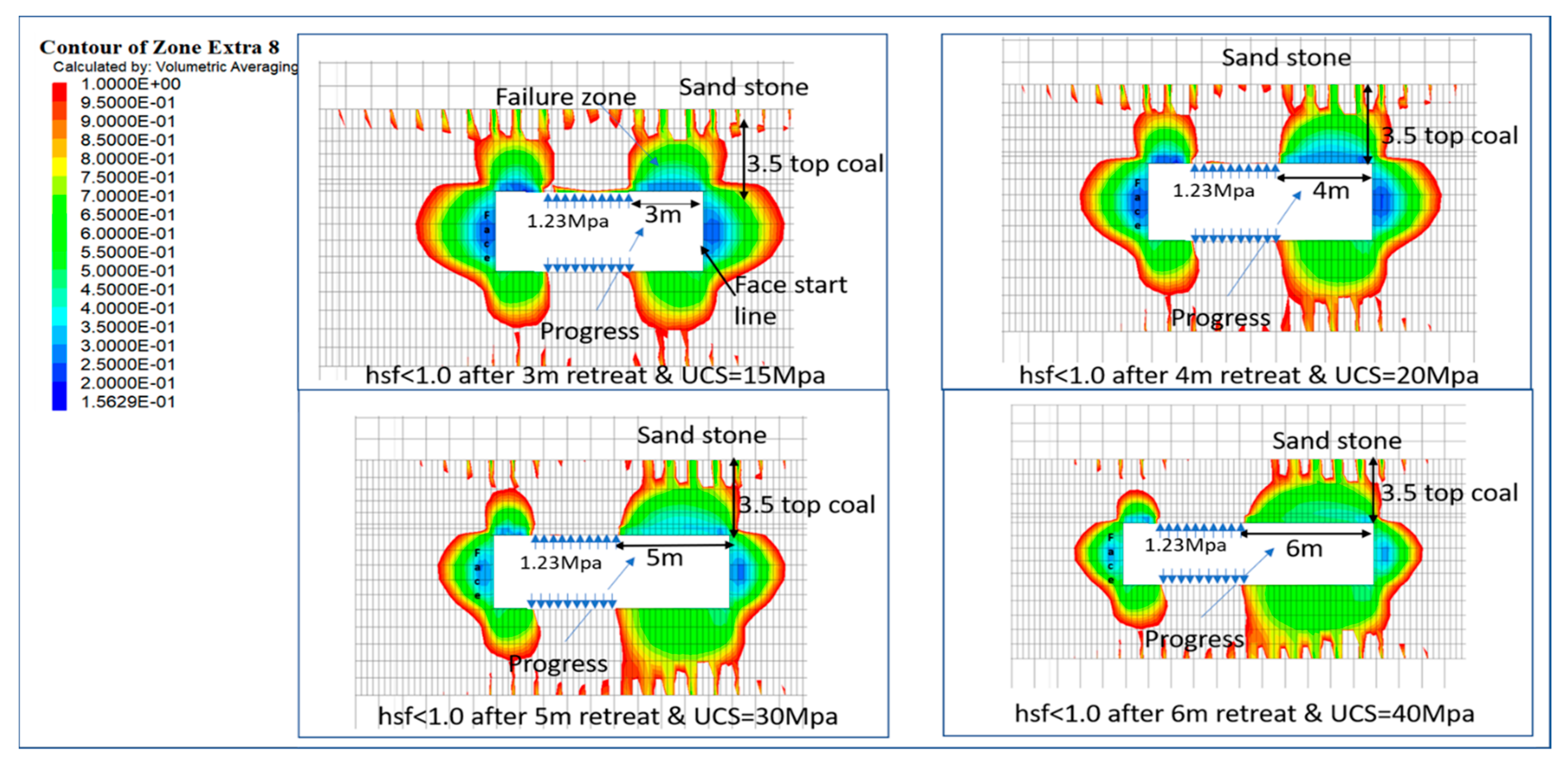
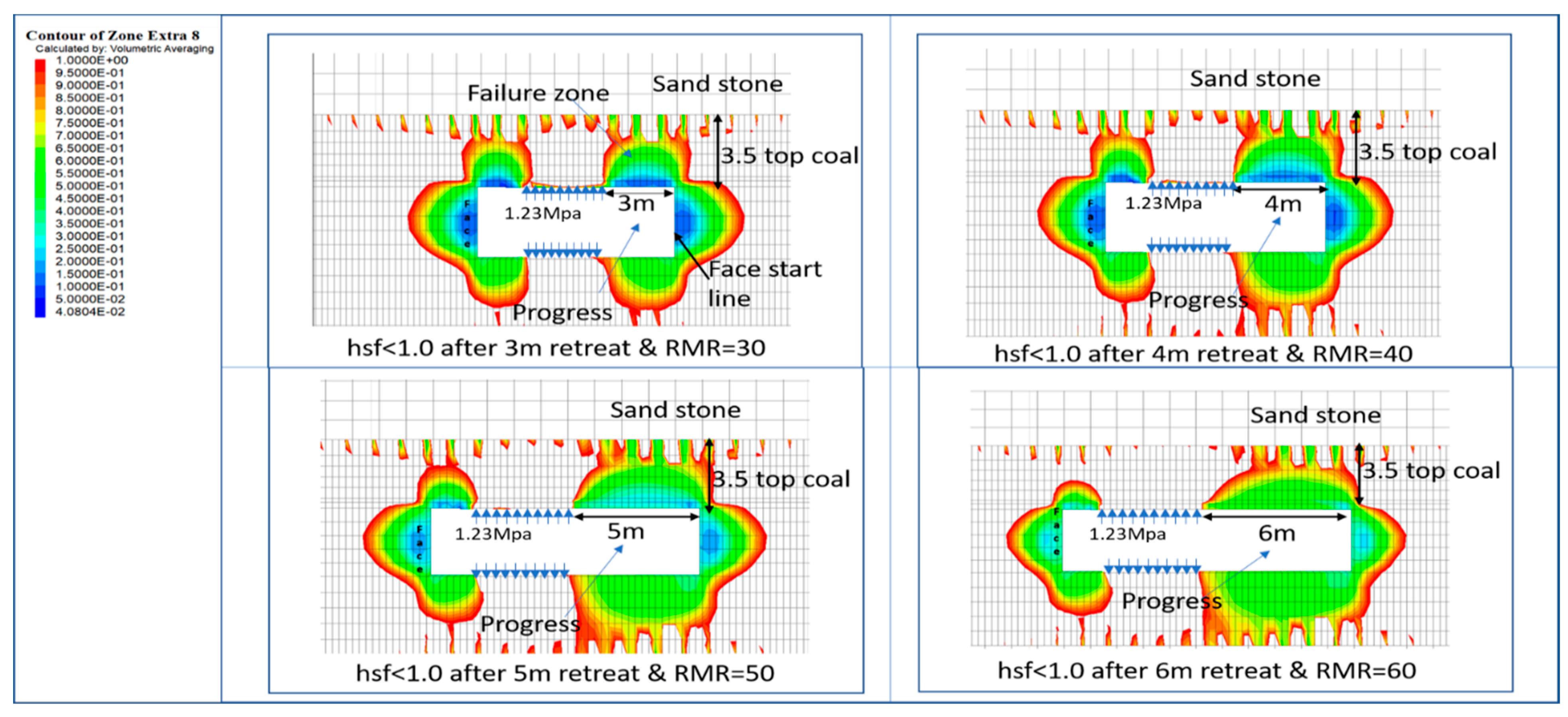
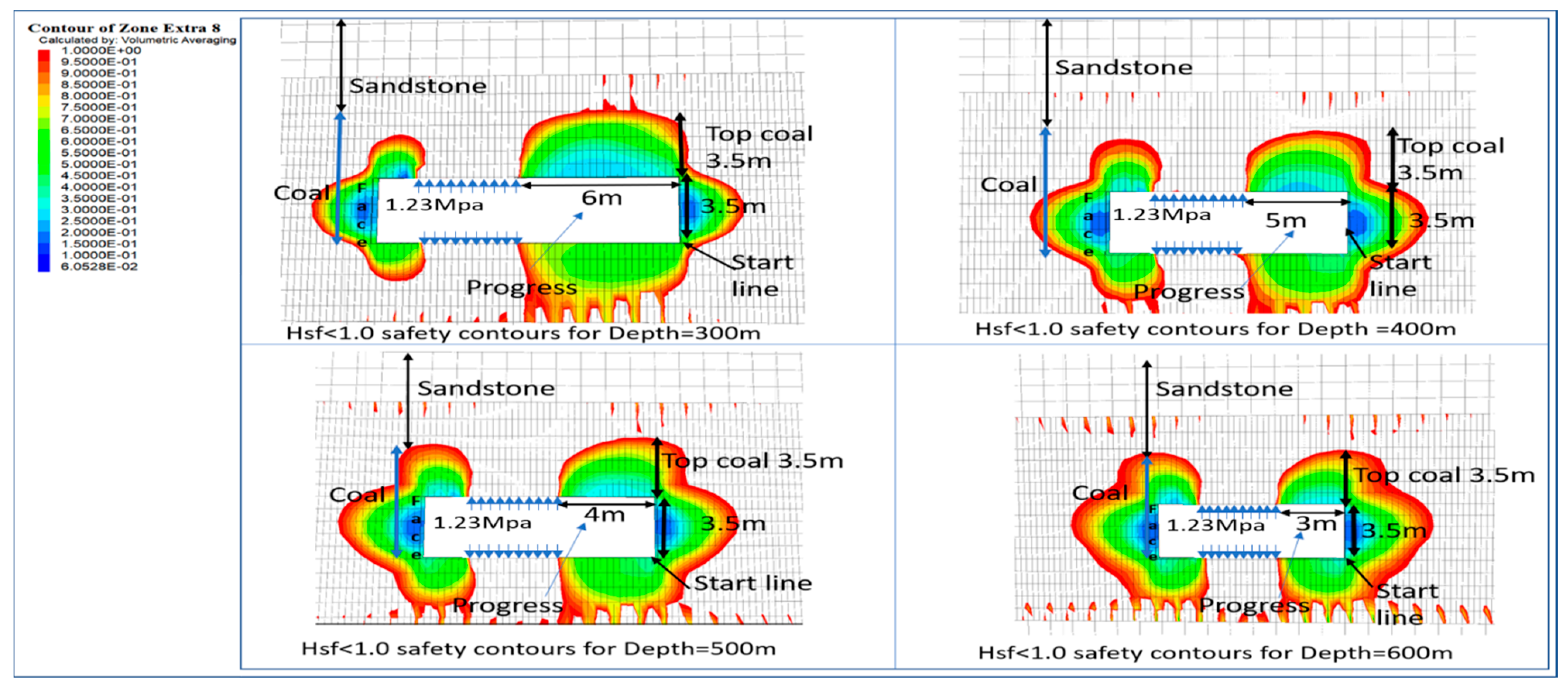


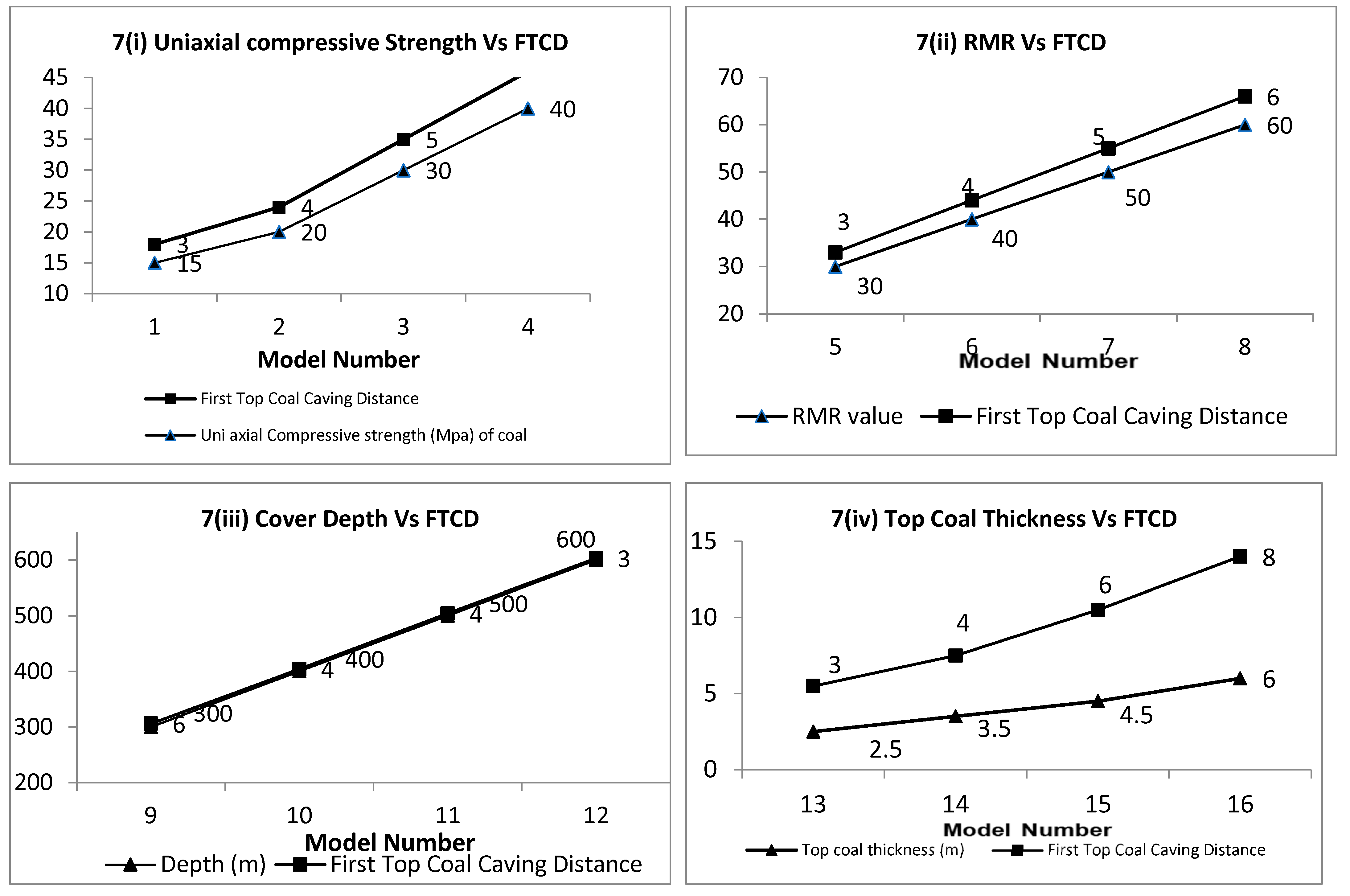
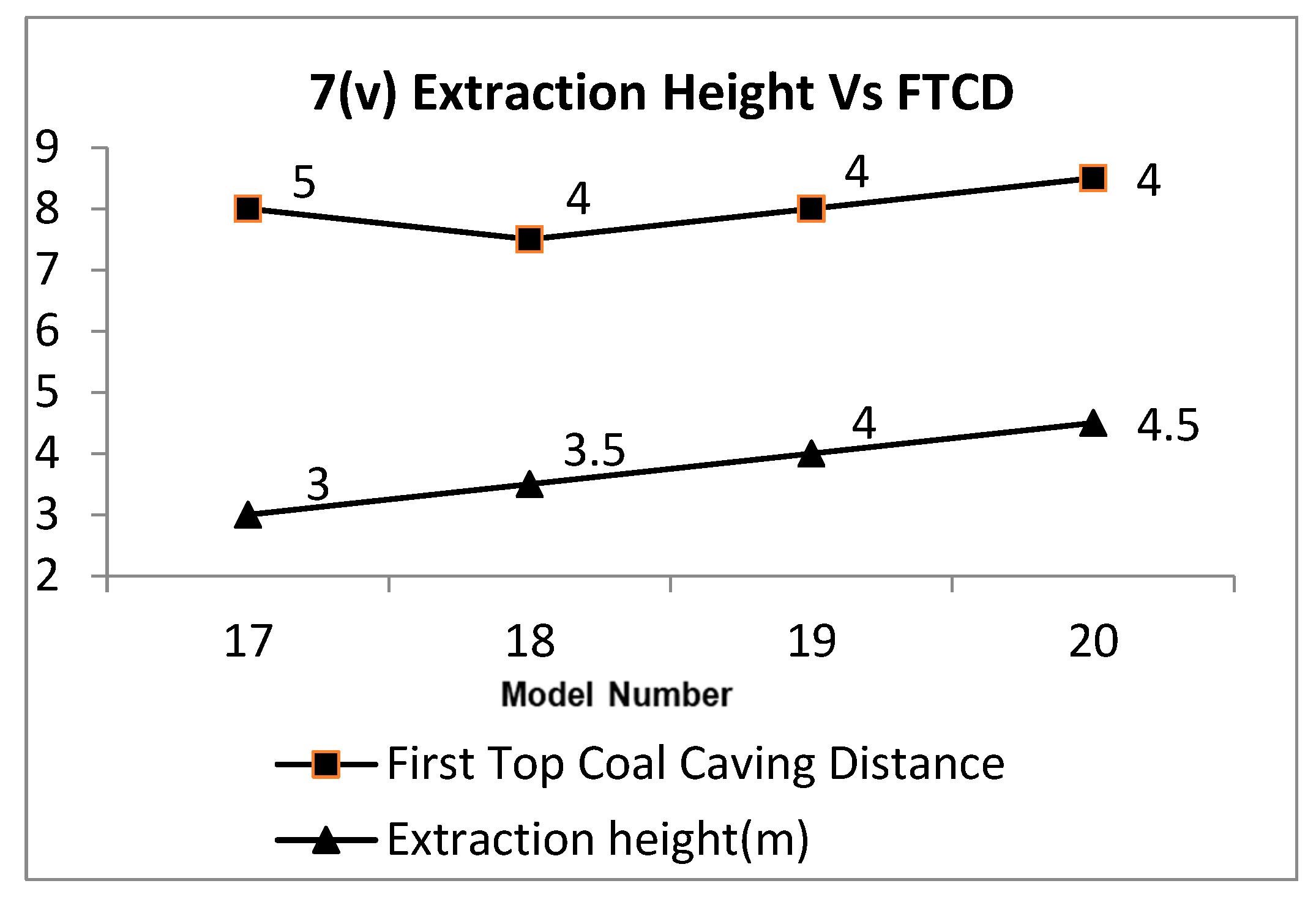
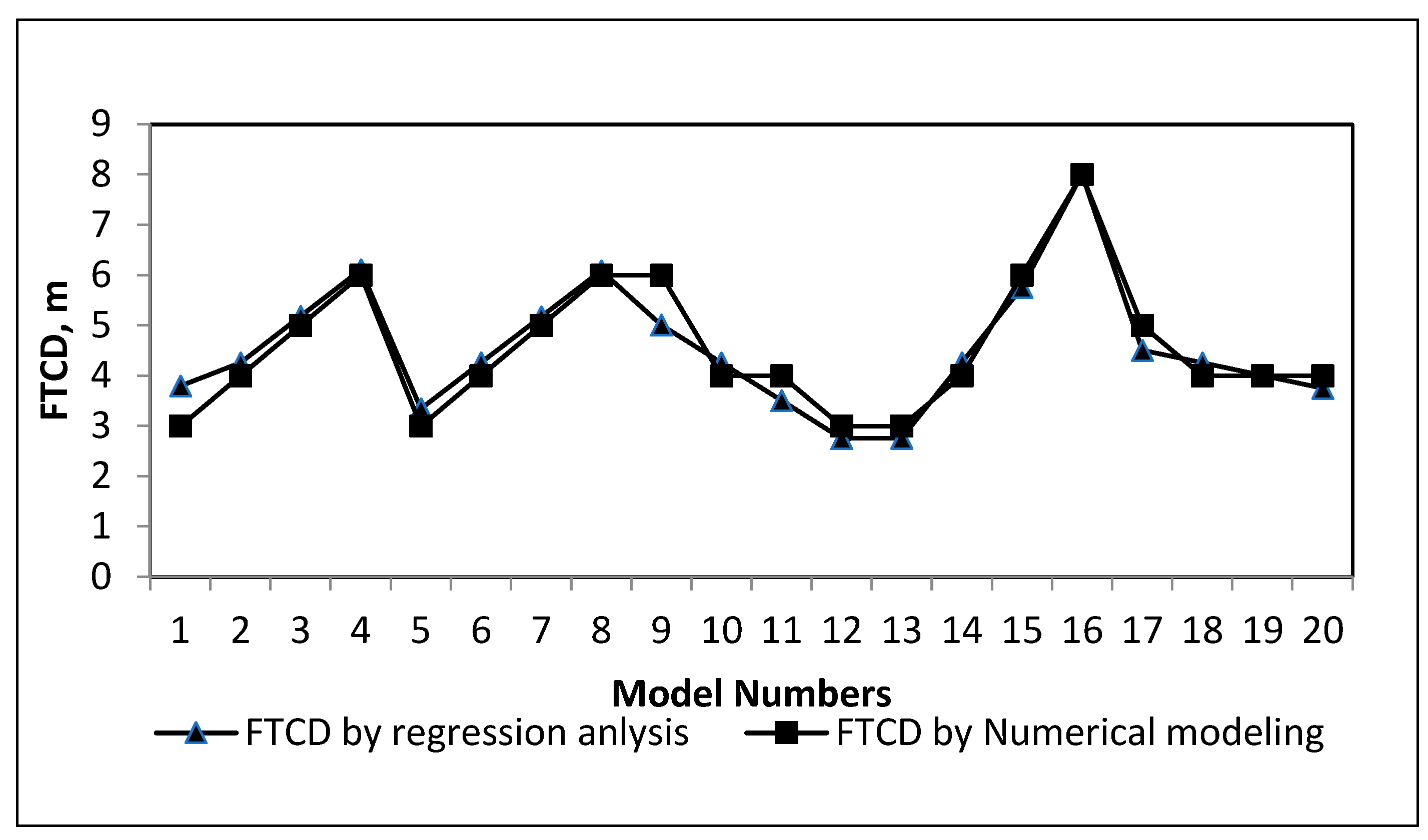

| First Top Coal Caving Distance (FTCD) (m) | Top Coal Recovery (%) | Remarks |
|---|---|---|
| Less than 7 | 100 | Extremely weak roof. Unless the overlying strata are not weak, dilution issues arise. |
| 7–15 | 79–100 | Good caveability. Most desired conditions |
| 15–23 | 59–79 | Fair caveability. Requires techniques for induced caving. |
| 23–32 | 39–59 | Poor caveability. Not recommended |
| More than 32 | <39 | Extremely poor caveability. Not recommended |
| Location | Material | Compressive Strength (MPa) | Tensile Strength (MPa) | Young’s Modulus (GPa) | RMR | Poisson’s Ratio |
|---|---|---|---|---|---|---|
| Bottom Stone | Sandstone | 19 | 1.9 | 5.0 | 60 | 0.25 |
| Coal seam | Coal | 20 | 2.0 | 2.0 | 40 | 0.25 |
| Main Roof | Sandstone | 13.5 | 1.25 | 5.0 | 60 | 0.25 |
| Coal seam | Coal | 21 | 2.1 | 2.0 | 46 | 0.25 |
| Upper main roof | Sandstone | 25 | 2.5 | 6.0 | 60 | 0.25 |
| Clay band | Clay | 21 | 2.1 | 4.0 | 46 | 0.25 |
| Sandstone roof | Sandstone | 25 | 2.5 | 5.0 | 60 | 0.25 |
| Scenario | Model Number | Extraction Height (m) | Top Coal Thickness (m) | RMR Value | Uniaxial Compressive Strength (MPa) of Coal | Depth (m) | First Top Coal Caving Distance Obtained from Numerical Modeling (FTCD) (m) |
|---|---|---|---|---|---|---|---|
| I (by varying UCS of coal) | 1 | 3.5 | 3.5 | 40 | 15 | 400 | 3 |
| 2 | 3.5 | 3.5 | 40 | 20 | 400 | 4 | |
| 3 | 3.5 | 3.5 | 40 | 30 | 400 | 5 | |
| 4 | 3.5 | 3.5 | 40 | 40 | 400 | 6 | |
| II (by varying RMR of coal) | 5 | 3.5 | 3.5 | 30 | 20 | 400 | 3 |
| 6 | 3.5 | 3.5 | 40 | 20 | 400 | 4 | |
| 7 | 3.5 | 3.5 | 50 | 20 | 400 | 5 | |
| 8 | 3.5 | 3.5 | 60 | 20 | 400 | 6 | |
| III (by varying depth of coal seam) | 9 | 3.5 | 3.5 | 40 | 20 | 300 | 6 |
| 10 | 3.5 | 3.5 | 40 | 20 | 400 | 4 | |
| 11 | 3.5 | 3.5 | 40 | 20 | 500 | 4 | |
| 12 | 3.5 | 3.5 | 40 | 20 | 600 | 3 | |
| IV (by varying top coal thickness) | 13 | 3.5 | 2.5 | 40 | 20 | 400 | 3 |
| 14 | 3.5 | 3.5 | 40 | 20 | 400 | 4 | |
| 15 | 3.5 | 4.5 | 40 | 20 | 400 | 6 | |
| 16 | 3.5 | 5.5 | 40 | 20 | 400 | 8 | |
| V (by varying extraction height) | 17 | 3 | 3.5 | 40 | 20 | 400 | 5 |
| 18 | 3.5 | 3.5 | 40 | 20 | 400 | 4 | |
| 19 | 4 | 3.5 | 40 | 20 | 400 | 4 | |
| 20 | 4.5 | 3.5 | 40 | 20 | 400 | 4 |
| Parameter | Value |
|---|---|
| Multiple R | 0.955481231 |
| R-squared | 0.912944384 |
| Adjusted R-squared | 0.881853092 |
| Standard error | 0.452649546 |
| Observations | 20 |
| Bed No. | Ht. Above Coal Seam, m | Bed Thickness, m | Density, gm/cc | CS, ksc | TS, ksc | Modulus of Elasticity, E, ksc | Caveability Index (CI) | RMR | |
|---|---|---|---|---|---|---|---|---|---|
| From | To | ||||||||
| No. 1 Seam | −3.50 | 0.00 | 3.5 | −1 | 281 | −1 | −1 | 0 | 43 |
| Caving Layer 1 | 0.00 | 6.63 | 6.63 | 2033 | 193 | 15 | −1 | 1194 | 45 |
| Caving Layer 2 | 6.63 | 24.33 | 17.7 | 2061 | 181 | 24 | −1 | 6919 | 61 |
| Caving Layer 3 | 24.33 | 54.46 | 30.13 | 2091 | 192 | 25 | −1 | 3860 | 48 |
| Caving Layer 4 | 54.46 | 55.95 | 1.49 | 2034 | 215 | 28 | −1 | 1632 | 49 |
| Bottom coal extraction height (EH) | 3.5 m |
| Top coal thickness (TC) | 3.5 m |
| RMR | 40 |
| Uni axial compressive strength of coal (UCS) | 44.6 Mpa |
| Depth of coal seam from surface (H) | 450 m |
| Sl. No. | Seam Name, Area | Mine | Company Name | Seam Thickness (m) | Extraction Height (m) | Top Coal Thickness (m) | RMR Value | Uni Axial Compressive Strength (Mpa) of Coal | Depth (m) | First Top Coal Caving Distance (FTCD), (m) |
|---|---|---|---|---|---|---|---|---|---|---|
| 1 | R-VI, Raniganj | Jhanjra | ECL | 5.5 | 3.5 | 2 | 58.6 | 15 | 150 | 5.1 |
| 2 | III Seam, Srirampur | IK1A | SCCL | 6.5 | 4 | 2.5 | 44 | 13 | 168 | 3.9 |
| 3 | SJ Seam, Mandamarri | MVK-II | SCCL | 6 | 3 | 3 | 53 | 28.5 | 140 | 7.6 |
| 4 | III Seam, Ramagundam-II Area | GDK8 INCLINE | SCCL | 10 | 4.5 | 5.5 | 62 | 21.4 | 180 | 10.5 |
| 5 | I Seam, Adriyala Projects Area | ALP | SCCL | 7 | 3.5 | 3.5 | 40 | 44.6 | 450 | 6.15 |
| 6 | III Seam, Adriyala Projects Area | ALP | SCCL | 10 | 4.5 | 5.5 | 57 | 31.8 | 600 | 7.8 |
| 7 | III Seam, Ramagundam-I Area | GDK 11 INCLINE | SCCL | 6 | 3.5 | 2.5 | 49 | 13.7 | 270 | 3.9 |
| 8 | King Seam, Kothagudem | PVK 5 INCLINE | SCCL | 8 | 4.5 | 3.5 | 52 | 11.3 | 250 | 5.1 |
| S. No. | LTCC | SPL | ||
|---|---|---|---|---|
| Name of Equipment | Quantity | Name of Equipment | Quantity | |
| 1 | ZF12000/25/38 four-legged face shield support | 138 | Two-legged DTDA version face shields | 139 |
| 2 | ZFG12000/28/42 four-legged end shield support | 8 | Two-legged DTDA version face end shields | 6 |
| 3 | MG650/1630-WD shearer | 1 | BUCYRUS DBT EL 3000 shearer | 1 |
| 4 | SGZ1000/(2 * 855) front AFC L = 256 m | 1 | 3 × 855 KW, 3.3 KV three-phase AFC | 1 |
| 5 | SGZ1000/(2 * 855) rear AFC L = 256 m | 1 | ||
| 6 | SZZ1200/525 BSL L = 45 | 1 | 400 KW, 3.3 KV, three-phase | 1 |
| 7 | ZY1100 self-moving device for stage loader | 1 | Self-moving device for stage loader | 1 |
| 8 | ZY2700 boot end for belt conveyor | 1 | Boot end | 1 |
| 9 | PCM525 crusher | 1 | 400 KW, 3.3 KV, three-phase crusher | 1 |
| 10 | Emulsion pump station (three pumps, two tanks) | 1 | Power pack (three high-pressure pumps, three cooling pumps, two booster pumps) including filter station and emulsion tank | 1 |
| 11 | Spraying pump station (three pumps, two tanks) | 1 | ||
| 12 | DSJ120/180/3 × 315 belt conveyor L = 2200 m | 1 | Gate belt conveyor—3.0 km | 1 |
| 13 | Load center (including control system and cable) | 1 | Load center (including control system and cable) | 1 |
| Sl. No. | Item | LTCC Viability October 2020 | |
|---|---|---|---|
| Performance Level | |||
| At 100% | At 85% | ||
| I | Production capacity (MTPA) | 3.750 | 3.188 |
| II | Cost of production | ||
| 1 | Wages | 341.08 | 372.81 |
| 2 | Power | 97.64 | 100.97 |
| 3 | Stores | 303.02 | 311.53 |
| 4 | Mine closure | 3.31 | 3.90 |
| 5 | Post-project EMP | 2.60 | 2.93 |
| 6 | General administration | 32.86 | 38.66 |
| 7 | Interest | ||
| (a) Loan capital | 0.00 | 0.00 | |
| (b) Working capital | 24.55 | 26.12 | |
| 8 | Depreciation | 197.34 | 221.85 |
| Total cost of production | 1007.40 | 1083.78 | |
| III | Average sales price | 3391.21 | 3391.21 |
| IV | Profit/loss | 2383.81 | 2307.44 |
| V | Financial IRR | 68.47% | 58.53% |
| S. No. | Sensitivity | Financial IRR | |
|---|---|---|---|
| Performance Level | 100% | 85% | |
| I | Base Case | 68.47% | 58.53% |
| II | Increase in Capital Cost | ||
| 10% increase over base | 67.40% | 57.53% | |
| 15% increase over base | 66.87% | 57.04% | |
| 20% increase over base | 66.35% | 56.56% | |
| III | Increase in Operating Cost | ||
| 10% increase over base | 65.66% | 55.86% | |
| 15% increase over base | 64.26% | 54.53% | |
| 20% increase over base | 62.87% | 53.21% | |
| IV | Increase in Capital and Operating Costs | ||
| 10% increase over base | 64.62% | 54.90% | |
| 15% increase over base | 62.74% | 53.12% | |
| 20% increase over base | 60.89% | 51.38% | |
| V | Fall in Grade | ||
| Base Case (54% G-9, 46% G-7) | 68.47% | 58.53% | |
| Total grade falls to G-9 | 67.81% | 57.61% | |
| Total grade falls to G-10 | 63.80% | 53.95% | |
| Total grade falls to G-11 | 48.88% | 40.34% | |
| VI | Increase in Total Cost and fall in Grade to G-11 | ||
| 10% increase in total cost and Coal Grade G-11 | 44.89% | 34.20% | |
| 15% increase in total cost and Coal Grade G-11 | 42.93% | 32.21% | |
| 20% increase in total cost and Coal Grade G-11 | 41.00% | 30.24% | |
Publisher’s Note: MDPI stays neutral with regard to jurisdictional claims in published maps and institutional affiliations. |
© 2021 by the authors. Licensee MDPI, Basel, Switzerland. This article is an open access article distributed under the terms and conditions of the Creative Commons Attribution (CC BY) license (https://creativecommons.org/licenses/by/4.0/).
Share and Cite
Balasubrahmanyam, N.; Budi, G. Techno-Economic Feasibility of the Longwall Top Coal Caving Method Based on the FTCD Index: A Parametric Case Study in India. Energies 2021, 14, 6115. https://doi.org/10.3390/en14196115
Balasubrahmanyam N, Budi G. Techno-Economic Feasibility of the Longwall Top Coal Caving Method Based on the FTCD Index: A Parametric Case Study in India. Energies. 2021; 14(19):6115. https://doi.org/10.3390/en14196115
Chicago/Turabian StyleBalasubrahmanyam, Nasina, and Gnananandh Budi. 2021. "Techno-Economic Feasibility of the Longwall Top Coal Caving Method Based on the FTCD Index: A Parametric Case Study in India" Energies 14, no. 19: 6115. https://doi.org/10.3390/en14196115





